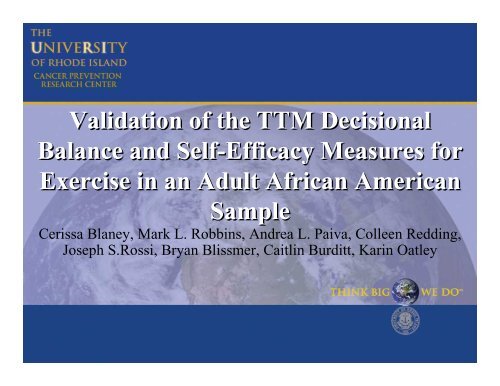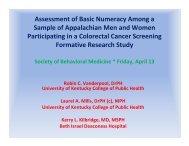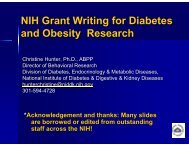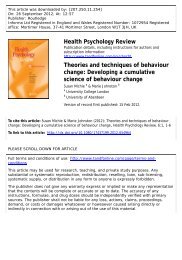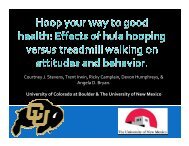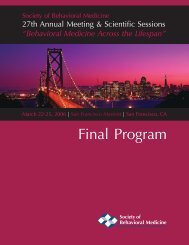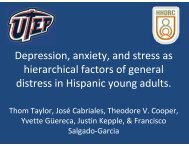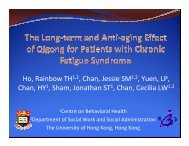Validation of the TTM Decisional Balance and Self-Efficacy ...
Validation of the TTM Decisional Balance and Self-Efficacy ...
Validation of the TTM Decisional Balance and Self-Efficacy ...
- No tags were found...
You also want an ePaper? Increase the reach of your titles
YUMPU automatically turns print PDFs into web optimized ePapers that Google loves.
<strong>Validation</strong> <strong>of</strong> <strong>the</strong> <strong>TTM</strong> <strong>Decisional</strong><strong>Balance</strong> <strong>and</strong> <strong>Self</strong>-<strong>Efficacy</strong> Measures forExercise in an Adult African AmericanSampleCerissa Blaney, Mark L. Robbins, Andrea L. Paiva, Colleen Redding,Joseph S.Rossi, Bryan Blissmer, Caitlin Burditt, Karin Oatley
Introduction• Exercise is crucial for prevention <strong>of</strong> chronicdisease• Physical Inactivity remains a public healthproblem• African Americans reports higher rates <strong>of</strong> chronicdisease & physical inactivity compared to Whites• Need for effective exercise interventionsparticularly for African Americans
Introduction• Effective interventions require validmeasures• <strong>TTM</strong> measures for exercise• Developed <strong>and</strong> validated in primarily whitepopulations• Not validated specifically for AfricanAmericans (Marcus et al 1992; Noar, 2003; Prochaska &Velicer, 1997)
Aims <strong>of</strong> <strong>the</strong> Study• <strong>Validation</strong> <strong>of</strong> <strong>the</strong> <strong>TTM</strong> <strong>Decisional</strong> <strong>Balance</strong><strong>and</strong> <strong>Self</strong>-<strong>Efficacy</strong> exercise measures in anAfrican American sample• Stage <strong>of</strong> Change• <strong>Decisional</strong> <strong>Balance</strong>• <strong>Self</strong>-<strong>Efficacy</strong>
Hypo<strong>the</strong>ses• H 1 : <strong>Decisional</strong> <strong>Balance</strong> model prediction: two-factoruncorrelated model• H 2 : Increase in Pros <strong>and</strong> a decrease in Cons across <strong>the</strong>Stages <strong>of</strong> Change• H 3 : <strong>Self</strong>-<strong>Efficacy</strong> model prediction: on-factor model• H 4 : Increase in <strong>Self</strong>-<strong>Efficacy</strong> across <strong>the</strong> Stages <strong>of</strong> Change• H 5 : Increase in self reported exercise across <strong>the</strong> Stages <strong>of</strong>Change
Sample Characteristics521 African American adults• Demographics– Mean age 37 years (range 18 to 70)– 79% female– 37% married or living with a partner– mean BMI <strong>of</strong> 29.1(SD =7.1)
Stage <strong>of</strong> Change5 04 03 02 010038.232.413.48.36.1P C C P R A M
Method• Confirmatory Factor Analysis EQS– Macro fit indices : χ 2 , CFI, GFI, AASR RMSEA– Micro fit indices: factor loadings• External <strong>Validation</strong> by <strong>the</strong> Stage <strong>of</strong> Change– MANOVA <strong>and</strong> ANOVA– Follow up tests <strong>and</strong> effect size
Measures• Stage <strong>of</strong> Change:o A staging algorithm representing <strong>the</strong> five stages <strong>of</strong>change• <strong>Decisional</strong> <strong>Balance</strong>:o 10-item measure: 5 Pros (α=.90); 5 Cons (α=.67)• <strong>Self</strong>-<strong>Efficacy</strong>:o 6-item measure: (α=.82)• Godin Leisure Time Exercise Questionnaire (QLTQ):o 3 Item measure: (two week test-retest reliability ranged.80-.94)
<strong>Decisional</strong> <strong>Balance</strong>: Confirmatory Model1. I would have more energy for myfamily <strong>and</strong> friends if I exercisedregularly.2. I would feel less stressed if Iexercised regularly.3. Exercising puts me in a bettermood for <strong>the</strong> rest <strong>of</strong> <strong>the</strong> day.4. I would feel more comfortablewith my body..660.848.738.710.686PROS(a=.847)<strong>Decisional</strong> <strong>Balance</strong>Uncorrelated Model(N=511)CONS(a=.737).574.567.662.658.5701. I would feel embarrassed ifpeople saw me exercising.2. Exercise prevents me fromspending time with my friends.3. I feel uncomfortable orembarrassed in exercise clo<strong>the</strong>s.4. There is too much I would haveto learn to exercise.5. Regular exercise would help mehave a more positive outlook onlife.AASR = .044CFI = .922GFI = .937RMSEA = .083X2 = 158.761* (dF=35)5. Exercise puts an extra burdenon my significant o<strong>the</strong>r.
<strong>Self</strong>-<strong>Efficacy</strong>: Confirmatory Model1. I am under a lot <strong>of</strong> stress..4872. I feel I don't have time..644SE(a=.795).650.674.7043. I have to exercise alone.4. I don't have access to exerciseequipment.AASR = .029CFI = .955GFI = .971RMSEA = .087X2 = 43.51* ( dF=9)N=508.6075. I am spending time with friends or familywho do not exercise.6. If <strong>the</strong> wea<strong>the</strong>r is bad (such as when it'sraining or too hot).
MANOVA: Pros <strong>and</strong> Cons by Stage5550T-Score4540ProsCons35PC(N=32)C(N=43)PR(N=199)A(N=70)M(N=169)Stage <strong>of</strong> ChangeMANOVA:F(8,1006)=6.08, p < .05, η 2 =.05;ANOVA (Pros): F(4, 504) = 12.13, p
ANOVA: <strong>Self</strong>-<strong>Efficacy</strong> by Stage5550T-Score454035PC(N=32)C(N=43)PR(N=199)A(N=70)M(N=169)Stage <strong>of</strong> ChangeF(4, 501) = 11.03, p all stages
ANOVA: GLTEQ by StageExercise bouts per week876543210PC(N=32)C(N=43)PR(N=199)A(N=70)M(N=169)Stage <strong>of</strong> ChangeF(4, 502) = 37.99, p
Discussion• Results comparable to previous research• Replication - validated <strong>TTM</strong> exercisemeasures DCBL <strong>and</strong> SE in AA sample• Cons did not differ by stage <strong>of</strong> change– Needs fur<strong>the</strong>r investigation• Gender Differences– Need a larger sample <strong>of</strong> African American
Limitations• Cross-Sectional Design• Stage distribution– Not recruited for exercise stage• Predominantly Female• Measure Development
Future Directions• Longitudinal Analyses• Invariance Testing (similar to Paxton et al , 2008)– Gender– Age– Ethnicity– Various SES groups– Region <strong>of</strong> <strong>the</strong> country
Questions
Staging• Precontemplation– Not thinking about exercising regularly in <strong>the</strong> next 6 months• Contemplation– Intend to engage in regular exercise in <strong>the</strong> next 6 months• Preparation– Intend to engage in regular exercise in <strong>the</strong> next 30 days• Action– Have been exercising regularly for less than six months• Maintenance– Have you been exercising regularly for <strong>the</strong> past six months or more
<strong>Decisional</strong> <strong>Balance</strong>:Items <strong>and</strong> DescriptivesPROS• I would have more energy for my family <strong>and</strong> friends if I exercised regularly,M= 3.93 (1.1)• would feel less stressed if I exercised regularly, M= 4.12 (1.0)• Exercising puts me in a better mood for <strong>the</strong> rest <strong>of</strong> <strong>the</strong> day, M= 3.98 (1.1)• I would feel more comfortable with my body, M= 4.20 (1.0)• Regular exercise would help me have a more positive outlook on life. 4.01 (1.1)CONS• I would feel embarrassed if people saw me exercising, M= 1.44 (1.0)• Exercise prevents me from spending time with my friends, M=1.42 (.83)• I feel uncomfortable or embarrassed in exercise clo<strong>the</strong>s, M= 1.38 (.89)• There is too much I would have to learn to exercise. M=1.24 (.69)• Exercise puts an extra burden on my significant o<strong>the</strong>r, M= 1.23 (.68)
<strong>Self</strong>-<strong>Efficacy</strong>:Items <strong>and</strong> Descriptives• I am under a lot <strong>of</strong> stress, M= 3.38 (1.3)• I feel I don’t have <strong>the</strong> time, M= 2.68 (1.3)• I have to exercise alone, M= 3.02 (1.5)• I don’t have access to exercise equipment, M= 2.77 (1.4)• I am spending time with friends or family who do not exercise, M= 2.84(1.4)• If <strong>the</strong> wea<strong>the</strong>r is bad (such as when it’s raining or too hot), M= 2.73 (1.4)
<strong>Decisional</strong> <strong>Balance</strong>:Alternative Model TestingModel χ2 DFχ 2 /DFratioAIC RMSEA GFI AASR CFIModel 1: Null Model 1637.05* 45 36.38 1547.05Model 2:Uncorrelated TwoFactor ModelModel 3: CorrelatedTwo Factor ModelModel 4: One FactorDCBL Model158.76* 35 4.54 88.76156.94* 34 4.62 88.94626.12* 35 17.89 556.12.08 .94 .044 .92.08 .94 .039 .92.18 .76 .09 .63
<strong>Self</strong>-<strong>Efficacy</strong>:Alternative Model TestingModel χ2 DFχ 2 /DFratioAIC RMSEA CFI GFI AASRModel 1: NullModel786.154* 15 52.41 756.15Model 2: OneFactor Model45.513* 9 5.06 25.51.09 .96 .97 .03


